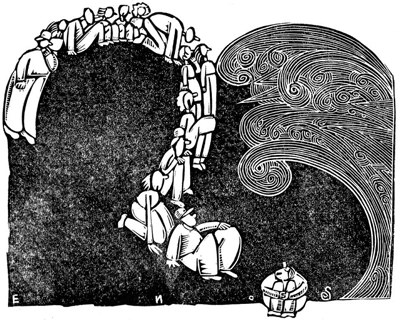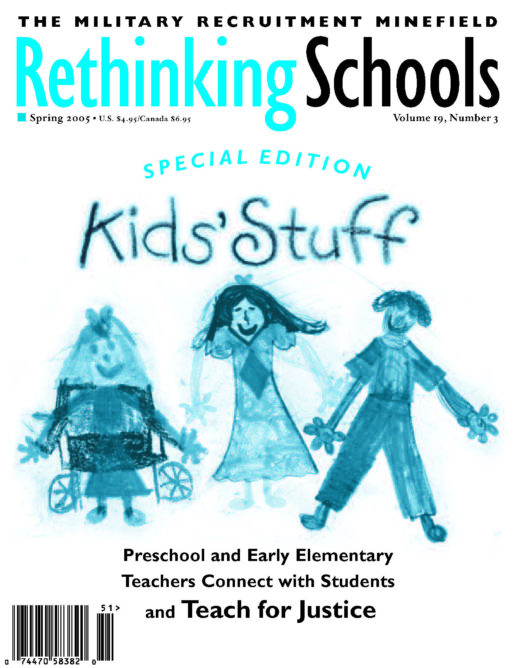The Tsunami and Other Disasters
Illustrator: Randall Enos

The Dec. 26 tsunami swept away the lives of more than 200,000 people and ravaged the livelihoods of millions more.
Throughout the world teachers and students discussed the tsunami and joined countless others in raising money for relief. Children organized bake sales, teenagers held benefit concerts, and teachers donated to relief organizations. In January, the national conference of the Australian Education Union asked all its members to donate a half-day’s pay to tsunami relief.
The quick and massive response to this disaster demonstrates the generosity and compassion that we believe is a dominant feature of our species. As one student remarked, “It’s natural for humans to want to help other humans in need of help.” In a world besieged by war, racial and ethnic oppression, and extreme poverty, the outpouring of solidarity for the victims of the tsunami is reassuring.
Teachers across the country responded to the tsunami with activities appropriate to their content areas: geography lessons, scientific study of plate tectonics, reading news stories, writing activities, and discussing feelings of loss. And the widespread media coverage of relief efforts made it easier for educators to encourage students to act on their concerns.
But educators also need to seize the opportunity to encourage students to pry beneath the headlines and to pursue critical questions raised by the tsunami and the world’s response. Here are some questions we believe are worth raising in the classroom when natural disasters such as the tsunami strike:
![]() Why has this tragedy received so much media and governmental attention while other tragedies are regularly ignored? Some maintain that because of the large number of European tourists in certain areas affected by the tsunami, the international press paid more attention to this tragedy than, say, the earthquake in Tangshan, China, in 1976, when an estimated half million people perished.
Why has this tragedy received so much media and governmental attention while other tragedies are regularly ignored? Some maintain that because of the large number of European tourists in certain areas affected by the tsunami, the international press paid more attention to this tragedy than, say, the earthquake in Tangshan, China, in 1976, when an estimated half million people perished.
Others argue that disasters without human causes are more likely to receive attention, because most international leaders and the corporate-controlled media don’t wish to examine the root causes of such man-made problems
Australian journalist John Pilger writes, “The victims of a great natural disaster are worthy . . . while the victims of man-made imperial disasters are unworthy and very often unmentionable.” He gives the example of Afghanistan, where he says that despite the rhetoric of the U.S. and British governments, more than 20,000 civilians have died since the United States invaded in 2001.
Another under-reported disaster of tsunami proportions is the world’s AIDS pandemic, which kills nearly three million people each year, one half million of those being children, most of them African. With more media attention, it’s possible that the public would have the ability to scrutinize government and corporate policies—such as the pharmaceutical industry’s refusal to put human need ahead of profit.
![]() Which other “man-made” disasters are worth remembering and teaching about? The British medical journal The Lancet reported last October that at least 100,000 Iraqis had lost their lives since the United States invaded in March 2003. The researchers reported that more than half of those who died were women and children killed in air strikes.
Which other “man-made” disasters are worth remembering and teaching about? The British medical journal The Lancet reported last October that at least 100,000 Iraqis had lost their lives since the United States invaded in March 2003. The researchers reported that more than half of those who died were women and children killed in air strikes.
It’s also worth recalling that between the 1991 Gulf War and the current war in Iraq, economic sanctions against Iraq led to an estimated death of more than half a million children. When “60 Minutes” questioned former Secretary of State Madeleine Albright about the extraordinary number of children who had perished from sanctions, she said, “It’s a hard choice, but I think—we think—it’s worth it.”
A recent UNICEF report estimates that 29,000 children under the age of five die each day from preventable diseases. By comparison, each week the same number of children die from preventable diseases as the total number who died in the tsunami. The UNICEF report says that some 640 million children lack adequate shelter, 400 million have no access to safe water, 270 million have no access to health care services, and 140 million—mostly girls—have never been to school.
![]() How did global “development policies” exacerbate the impact of the tsunami? Adhering to a strategy of export-led economic growth, poor countries have often sacrificed the environment to “development.” Organi-zations like the World Bank and the International Monetary Fund (IMF) have pressed governments to adopt policies that compromise the natural environment’s ability to “defend” itself, in exchange for needed loans. As the environmental organization Friends of the Earth put it:
How did global “development policies” exacerbate the impact of the tsunami? Adhering to a strategy of export-led economic growth, poor countries have often sacrificed the environment to “development.” Organi-zations like the World Bank and the International Monetary Fund (IMF) have pressed governments to adopt policies that compromise the natural environment’s ability to “defend” itself, in exchange for needed loans. As the environmental organization Friends of the Earth put it:
In many parts of the affected areas where dense mangroves and coral reefs once acted as natural buffers between the sea and coast, other developments have taken place, such as construction of hotels, shrimp farms, coastal highways, housing, and commercial development.
…Tragically, the full fury and wrath of the tidal waves were felt in areas where nature’s green belts of coral reefs and mangroves no longer exist or were never present in the first place.
On many levels, the very policies that the United States has pushed through the IMF, the World Bank, and free-trade agreements have contributed in no small part to dislocation and poverty among hundreds of millions of the world’s people. For example, in Mexico as many as three million farmers have lost their jobs as a result of cheap U.S. corn and rice exports and other U.S.-supported economic “reforms.”
![]() What is the responsibility of the U.S. government to help victims of natural and man-made disasters? Teachers might ask students to compare the U.S. government’s $350 million contribution to that of other countries. Students can look at total amounts of aid given, but also aid as a percentage of GNP. What observations can we make based on these calculations?
What is the responsibility of the U.S. government to help victims of natural and man-made disasters? Teachers might ask students to compare the U.S. government’s $350 million contribution to that of other countries. Students can look at total amounts of aid given, but also aid as a percentage of GNP. What observations can we make based on these calculations?
The New Yorker questioned whether President Bush’s Dec. 29 statement—”We’re a very generous, kindhearted nation”—was not “unseemly” and “boastful” given that other nations (Australia, Germany, Japan) had been more generous in absolute terms “and perhaps a dozen other countries have been more so in per-capita terms.”
The New Yorker went on to say that the tsunami relief the United States provided “will come at the expense of victims of disasters yet to occur,” because the administration used money from the U.S. Agency for International Development in order to respond to the tsunami without “undermining Mr. Bush’s other priorities,” such as making his tax cuts permanent.
When government representatives met at the Earth Summit in Rio de Janeiro in 1992, they adopted a program for action under the auspices of the United Nations that included an Official Development Assistance (ODA) aid target of 0.7 percent of gross national product (GNP) for rich nations. But the United States contributes a smaller percentage of its GNP —0.13 percent—to foreign aid than any other industrialized nation.
Instead of increasing development aid—and changing the nature of foreign assistance so it actually helps sustainable development and doesn’t just benefit U.S. corporations—the United States has spent hundreds of billions of dollars in a seemingly endless war in Iraq. In fact, the entire amount of aid the United States pledged to the tsunami relief efforts—$350 million—would pay for just three days of the Iraq war.
As educators, we can build on the empathy that our students and colleagues have shown for the victims of the Dec. 26 tsunami. We can never alleviate the terrible suffering of those who lost loved ones and homes, or experienced debilitating physical and psychological trauma in that disaster. But we can teach our students to look beyond the headlines and to understand why natural disasters can be made worse by poverty as well as by social and economic policies. We can also build solidarity with people who are trying to alleviate man-made disasters, like war and poverty.

